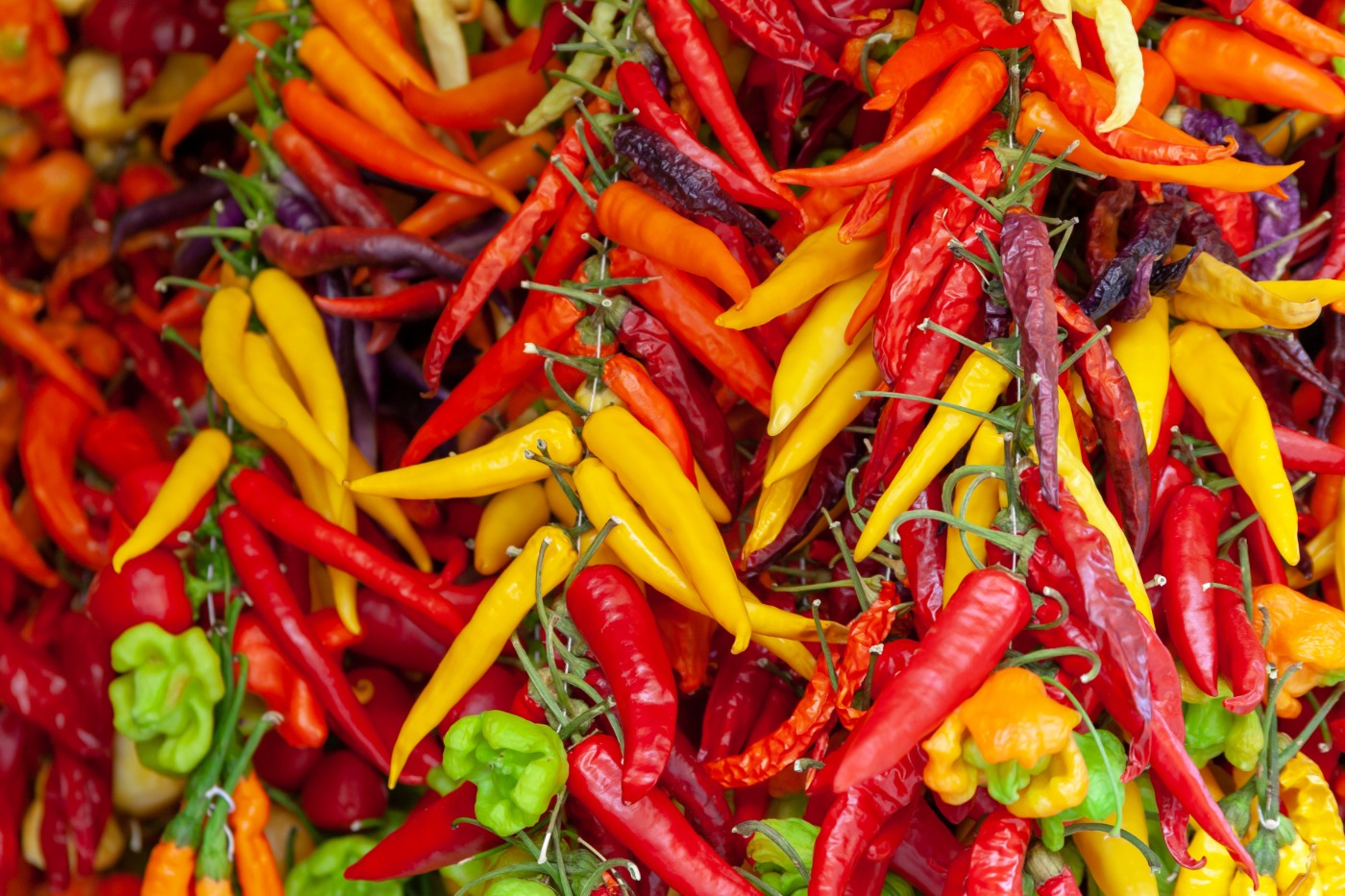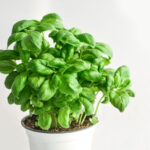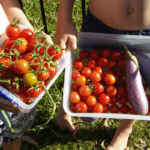This post may contain affiliate links.
Yes, you can grow chillies from supermarket chillies, in fact, chillies are one of the best plants and food crops to grow from supermarket scraps. Our post tells you how to grow chillies from supermarket chillies, to save you money by growing your own food. You can grow edible plants indoors, or outside in raised beds, pots, or in the ground, we’ll tell you what you need to know. These hot peppers come in many varieties and are a good source of vitamins and minerals. Did you know that home grown food fresh from your garden has way more nutrients (and fewer chemicals) than supermarket bought food? Chillies are easy to grow and are a good first crop to grow if you’re new to food gardening.

The chillies you grow from supermarket chillies may not grow true, this means you may get a different type of chilli than the parent fruit. This can happen because of cross-pollenation but in my experience it’s rare, it doesn’t happen often at all. If this is something that bothers you spend a dollar or two on a packet of seeds.
Chillies are a very easy food plant to grow in the tropics or in warm climates, but in cooler climates, like the US gardening zones further north, the UK, or colder parts of Australia you may have to overwinter your chilli plants indoors or in a greenhouse. We can grow chilli plants year-round as a perennial in warmer climates, but if you get a frost you may prefer to grow chilli plants as an annual.
In the very warm wet tropics on Australia’s Far North Queensland coast, chillies grew year-round (Cairns, Port Douglas etc.). Now, on the tablelands, we get a few peppers throughout the year, our major harvests are in early spring and into summer. As you get into the wet season the fruits may start to struggle. Because chillie seeds like quite a bit of warmth to germinate, put off starting them until spring is starting to warm things up.
I use a simple plastic greenhouse to help my seeds along in late winter or early spring. I have one like this and the shelves are really useful in the limited space on my deck.
I have some chilli plants growing in the shade, some in full sun, they don’t seem to mind too much in our hot sunny climate, but most people will tell you chilli plants need full sun and warmth, which means at least 6 hours of sun per day.
This, of course, depends on your location and the sun’s intensity. In cool climates, find a really warm sunny spot or a window that gets good sun. Indoors, grow lights will always help you grow bigger plants, faster, see them here. They’re very affordable and they work. I use this exact one.
Grow Chillies From Supermarket Chillies
This is how you grow chillies from supermarket chillies. Choose a chilli that looks ripe and healthy from the supermarket. When you get home slit it open and scrape out the seeds with a knife. Set them to one side and let them dry out for a while, or you can plant them straight away.
Chilli seeds can be tricky to germinate and need quite warm temperatures. For germination you need a temperature around 22 to 35C, that’s 75 to 95C. I use a heat mat to help chilies germinate in winter sometimes, one like this. I also use heating devices like this to keep newly hatched chicks and keets warm, so it’s multi-purpose.
They also don’t germinate very fast, germination is said to take 7 to 21 days for chilli seeds, but I’ve seen them germinate faster.
You can germinate chilli seeds on damp kitchen paper sealed inside a plastic bag and then transfer them to a soil or potting mix, or you can sew them directly into soil and water them in.
How deep to sew chili seeds? Plant them about 5mm, half a cm deep. That’s 3/16 inch for Americans.
Water them in, don’t soak them. Keep the soil moist every day until you see your first green shoots. Do not let cats, chickens, or dogs get near your seed trays or pots! We have to chicken-proof everything on our farm. I just put a piece of aviary mesh over my seedlings if I need to.
Continue to keep your plants moist and provide sunlight as they grow. If you plan to transplant them out in the garden wait until they are 5 to 10 cm tall and have their first true leaves. It’s best to not transplant them as this will set them back a little, so if possible sew them where you plan to grow them, but don’t worry, they should do fine once they’ve recovered from being moved.
As chili plants grow over a long season you’ll need to fertilise them from time to time. You can use a home made fertiliser (worm tea, compost, worm castings etc. ) or buy a well balanced fertiliser that’s not too high in Nitrogen. Nitrogen will encourage a lot of leafy growth, phosphorous boosts fruit production in all plants, potassium being the other key mineral.
Some chili plants, not all, require staking or support. Simply tie your plant to a bamboo cane or metal or plastic stake with string, or whatever you have on hand. I have huge chili bushes and they have never been staked, but young chili plants do tend to fall over and maybe snap if they’re laden with fruit.
When to Grow Chillies?
The best time to grow chili plants is when it’s warm, after the first frost, but of course, if you’re growing them indoors or with added heat this won’t matter so much. To produce fruit and allow it to ripen your chili plants need about 60 to 100 days, 3 months or so.
If you’re in a cooler climate be sure that you have at least 3 months for your chili plants to grow. Chili plants don’t enjoy temperatures below 10C even at night, so they’ll do best in summer or in warmer climates, or, need some additional heat to fruit well.
A chili plant doesn’t produce fruit all at once, and a small, young plant may have one ripe chili one week, another the next, so for a good supply of chillies grow a lot of plants, or allow a lot of time for your chili crop to ripen. You can, of course, harvest chillies green, before they turn red, orange, or purple.
If you check on the back of a seed packet in a supermarket or nursery, the time from planting to harvest should be indicated, usually in days.
Pests and Diseases in Chillies
Look out for fruit flies, aphids, blossom end rot or bottom end rot, whitefly, sunscald and bacterial wilt. Also there are lots of birds and garden pests that will eat chillies, you’ll need to protect them.
Ducks seem to really like eating habaneros and flocks of cetain birds can pick a chili bush clean, they’re attracted by the red colour, so if you have a bird problem, pick them green or net the chillies.
Rats, mice, and possoms will also eat chillies sometimes, particularly low hanging fruit, although in general they seem to prefer eggplants and tomatoes.
Chillies are from the same family as tomatoes, family solanaceae so, like tomatoes they can exhibit blossom end rot. This disease is caused by a lack of calcium in the soil. To combat this you can save egg shells, roast them in the oven and grind them to a powder in your oved, sprinkle this powder into your pots or beds and water in. It’s best to do it regularly, before you see signs of blossom end rot.
Fusarium wilt and verticillium wilt are caused by fungi in your soil. Some varieties will be resistant to these diseases, others will become sick and die. The only way to avoid these diseases is to use clean, bagged, soils and composts and clean pots every time. Your pots must be raised and have no contact with the soil. These diseases also affect tomatoes if you have these diseases in your soil.
Cutworms, a moth larva or caterpillar, can also be a problem in your garden.
How Much Fruit Can a Chili Plant Produce?

I picked all of these chillies from 1 plant (grown from supermarket bought red chillies) on one day. Some of these chillies are starting to wrinkle, I left them on the plant for a few days too long, but they’re still fine to eat. Harvest chillies using snips or scissors, they keep quite well in the crisper draw of the fridge for a week or so.
What To Do With Your Chillies?
There are lots of things you can do with chillies once harvested and they’re a good source of vitamin C. Eat them raw, cook with them, pickle them, dehydrate them to make chili powder, make sauces and ferments. Supermarket chillies are expensive (I’ve seen $30 to $40 per KG) and having your own supply of chillies saves you money, for sure. Its also better for the environment to grow your own rather than have this fruit shiped around the world, plus a fresh chili will have more vitamins and minerals than an older one on a supermarket shelf.








